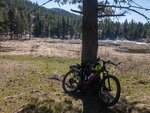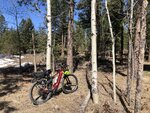When I purchased my Giant Phantom in early March I was looking to use it to cycle some of my regular routes but also use it in lieu of my vehicle for running errands, heading to the tennis courts and birding. Well there is no tennis until further notice but I have been running simple errands and have started visiting some of my birding spots on the ebike. In this part of North America the snow is disappearing at lower elevations, lawns are greening up and buds are starting to flush.
That means the birds are starting to return and pair up. Species that we see now are usually passing through from wintering in Mexico and south, on their way to breeding grounds in the arctic. This last week I spotted 3 flocks of sandhill cranes about 200m overhead as they slowly make their way northward. Warblers and hummingbirds should be starting to arrive any day now. Some of these stay year round while others are just here for lunch and a nap before heading north.
On Wednesday I made my third attempt to cycle to Ritchie Lake just north of here. Both previous attempts I aborted due to ice on an isolated, and infrequently travelled road. This time success.
Ritchie Lake is really just a duck pond that was rehabilitated approximately 5 years. First step was to fence out the cattle who had used it as a watering spot. We have free range cattle in this part of the country on both private and Crown lands. Ranchers let them out in the spring and collect them in the fall when frost starts to appear. But the cattle, an invasive species, can really make a mess of things both through trampling and "recycling" of their food.
The "lake" has recovered very nicely. As soon as the ice starts to leave the waterfowl arrives. Then there are the other woodland birds that live in the area including warblers, swallows, hawks, woodpeckers, chickadees, robins etc.

Garnett Lake is a local reservoir that serves part of our community both for domestic and agriculatural use. Two weeks ago it was still very much frozen over, this week the ice is all gone.
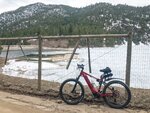
British Columbia is still a very young province. The interior of the province was settled by Europeans in the early 1900's although First Nations have been here for thousands of years. The route I was following was originally a First Nations trail and then was used by traders and trappers and became one of the routes to the BC gold fields in the 1880's.

For those of you in Europe this photo is not a big deal; concrete fence post. So what? In this part of the world, where timber is the primary building material, a concrete fencepost is very rare. Sort of like finding a wooden fencepost is some parts of Europe.

A few images of the trees at this elevation. These are ponderosa pine. As you increase in elevation you move into Douglas-fir forests, then pine, then spruce, then balsam (Abies) then into alpine.
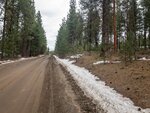
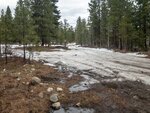
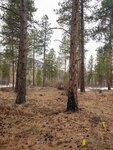
And finally, mighty Ritchie Lake. There was still ice on 25% of the lake, and standing water in puddles outside of the lake. This water is all from snow melt. The first waterfowl were staking their places on the lake. A small group of mallards and a solitary American coot. My bonus for the day was watching a male red-naped sapsucker drumming on a dead aspen for 10 minutes. His mate visited very briefly to inspect his prowess. A new species for my life list.
